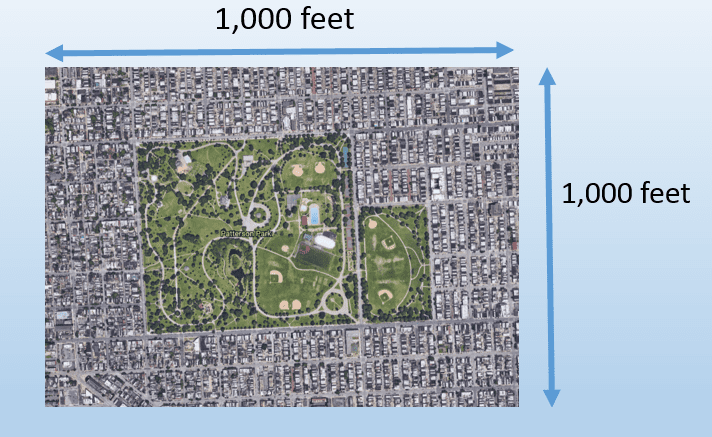It is difficult to create a geographic boundary line that captures those that benefit park users and those that have increased property values due to proximity to Patterson Park. For instance, the Master Plan process indicated that the majority of park users resided in the neighborhoods surrounding the park.[1] The borders of some of those neighborhoods, however, expand well beyond the Patterson Park area. In addition, defining all the properties that benefit economically from proximity to Patterson Park is a difficult task considering the different types of properties, different distances from the park and the different amenities offered at Patterson Park along with other factors.[2]
Despite this difficulty, the proximate principle and related studies provide general indications of how to establish these boundaries (see article nos. 8 and 9 in this series). For instance, John Crompton suggested in his review of the literature that for community parks over forty acres, property values were increased as far as 1,500 to 2,000 feet away from the park.[3] When looking at all the parks including suburban, urban and specialty parks, Crompton suggests a general rule of thumb indicating that the majority of the economic benefit from all parks occurs between 500 and 600 feet.” He acknowledges this general rule can be modified by taking into account the character and size of the park at issue.[4] For instance, Crompton notes that for larger parks, the economic value likely extends beyond this 600-foot zone as park users likely extend beyond this boundary.[5]
A study of property values in Portland Oregon indicated that properties within 1500 feet of a park had a positive impact on property values.[6] Another study of parks focusing on Dallas, Texas also confirmed increased property values with the majority of the property increases occurring within 800 feet of the park.[7] Regarding Baltimore parks, the Troy and Grove study generally indicates that low crime parks have the greatest effect on property values up to approximately 1,000 feet depending on the level of crime in the area.[8] Given these studies, a boundary of 800 to 1,000 feet from Patterson Park would be a reasonable boundary line to capture those that benefit from Patterson Park.
[1] Patterson Park 2016 Master Plan at Appendix B, Seasonal Field Study of Patterson Park in Baltimore, Maryland (2015) https://drive.google.com/file/d/0BzmWPd92eAaWcWlBU3B3c3d1dmc/view.
[2] Despite this difficulty, certain models can take into account different variables and provide an estimation of the value added to properties surrounding Patterson Park at varying distances. Timm Kroeger, National Council for Science and the Environment Open Space Property Value Premium Analysis at appendix 2 (2006) https://defenders.org/sites/default/files/publications/open_space_property_value_premium_analysis.pdf.
[3] John Crompton, The Impact of Parks and Open Spaces on Property Taxes 1, 14, Trust for Public Land (Constance T.F. de Brun ed., 2007), http://cloud.tpl.org/pubs/benefits_econbenefits_landconserve.pdf (stating that the “proximate principle states that the market values of properties located near a park or open space (POS) frequently are higher than those of comparable properties located elsewhere.”).
[4] Crompton at 116.
[5] Crompton at 116.
[6] B. Bolitzer & N.R. Netusil, The Impact of Open Space on Property Values in Portland Oregon, 59 J. of Envtl. Mgmt. 185, 190-92 (2000).
[7] A.R. Miller, Valuing Open Space: Land Economics and Neighborhood Parks 86 (2001) (unpublished thesis), https://dspace.mit.edu/handle/1721.1/8754#files-area.
[8] Austin Troy, Morgan J. Grove, Property Values, Parks, and Crime: A Hedonic Analysis in Baltimore, MD, 87 Landscape and Urb. Plan. 233, 241-42, figs. 3, 5, 7 (2008).

Be the first to comment on "No. 13 – Proposed boundaries of a special benefits district for Patterson Park"